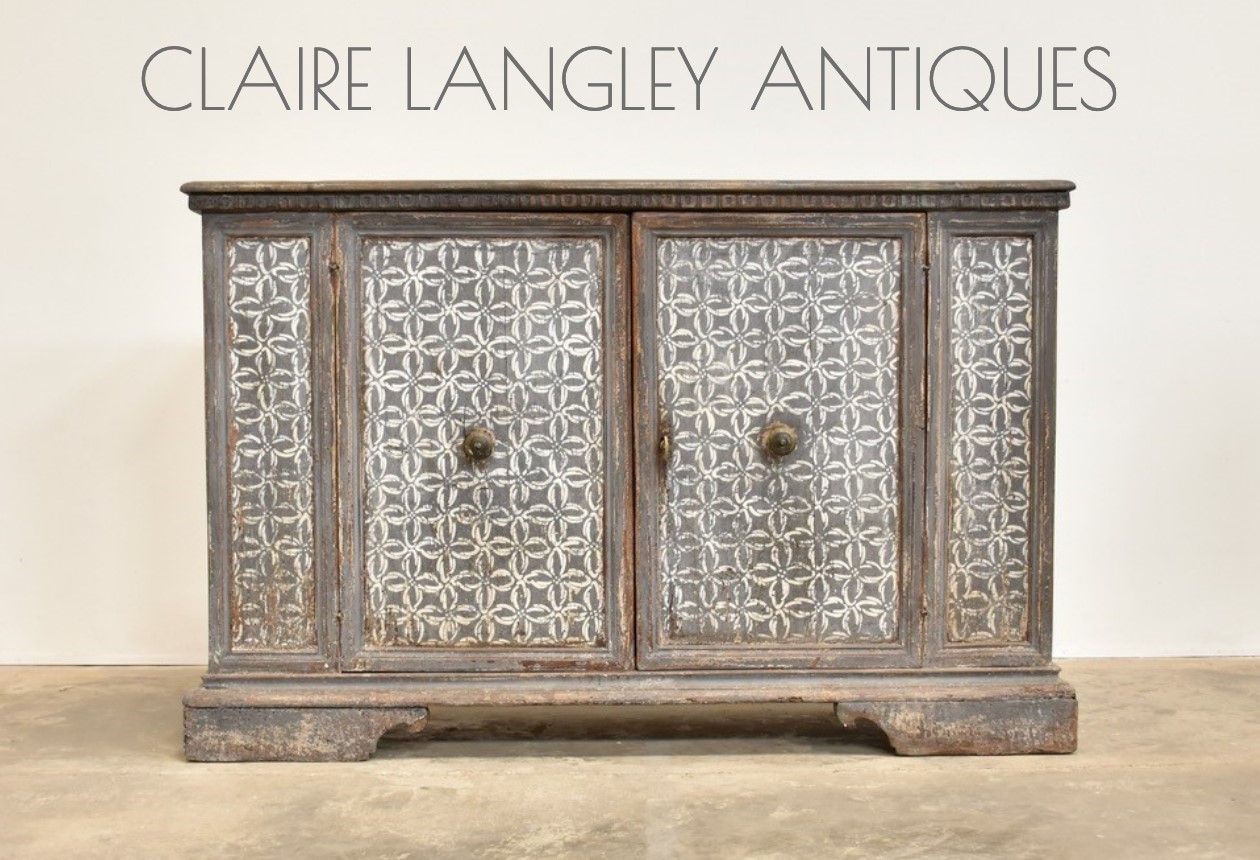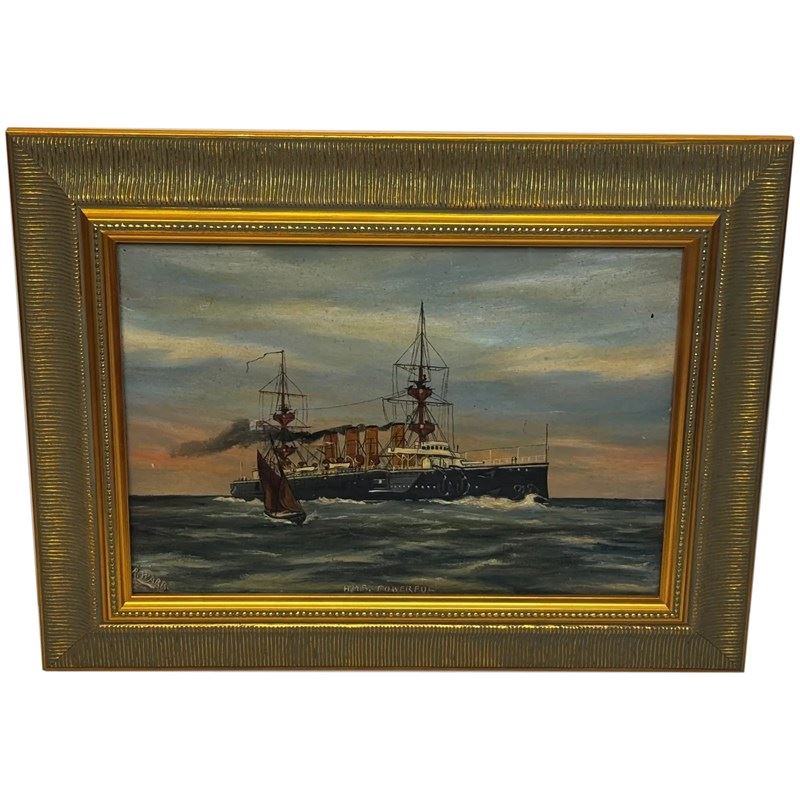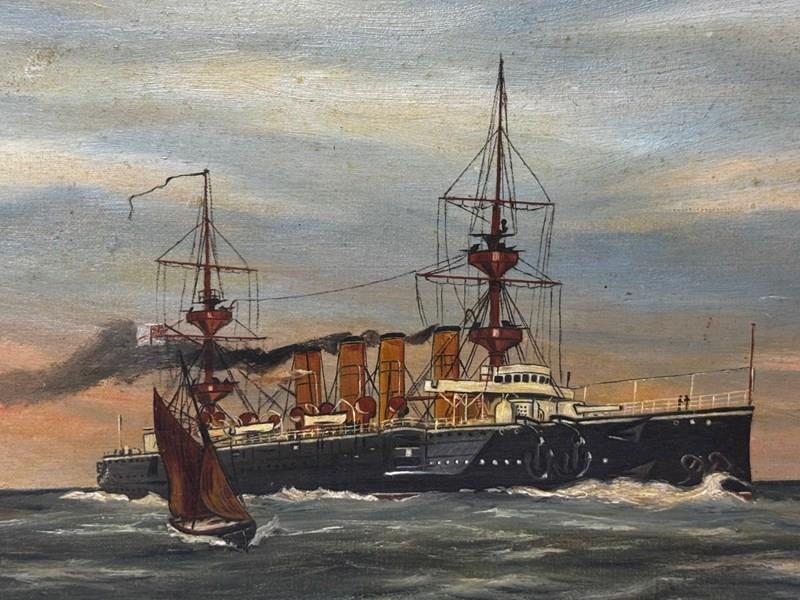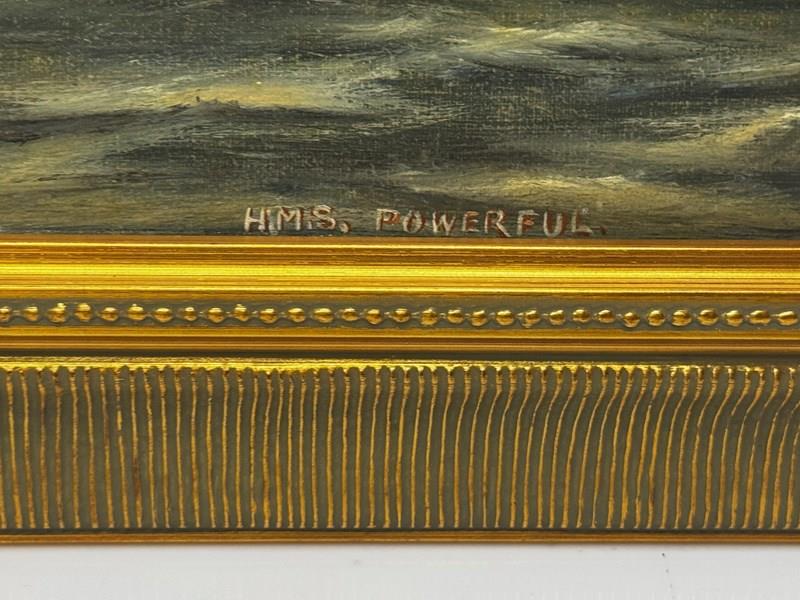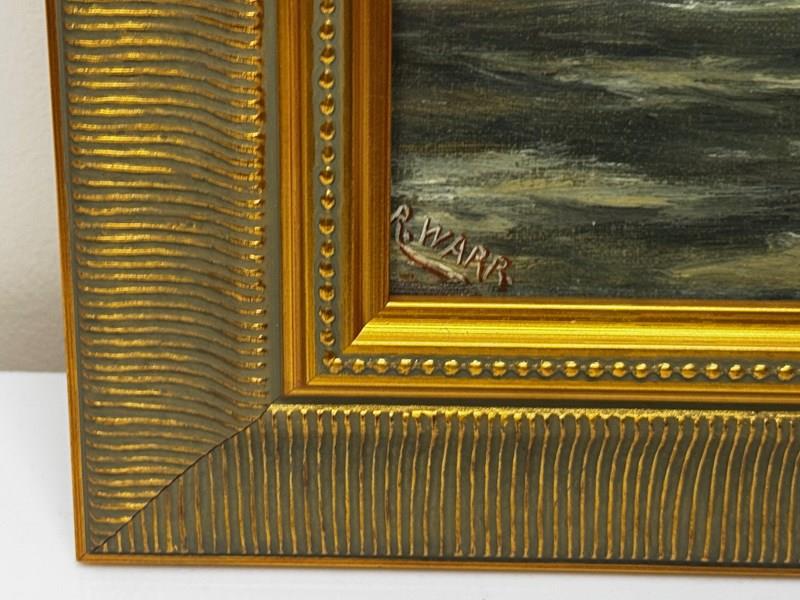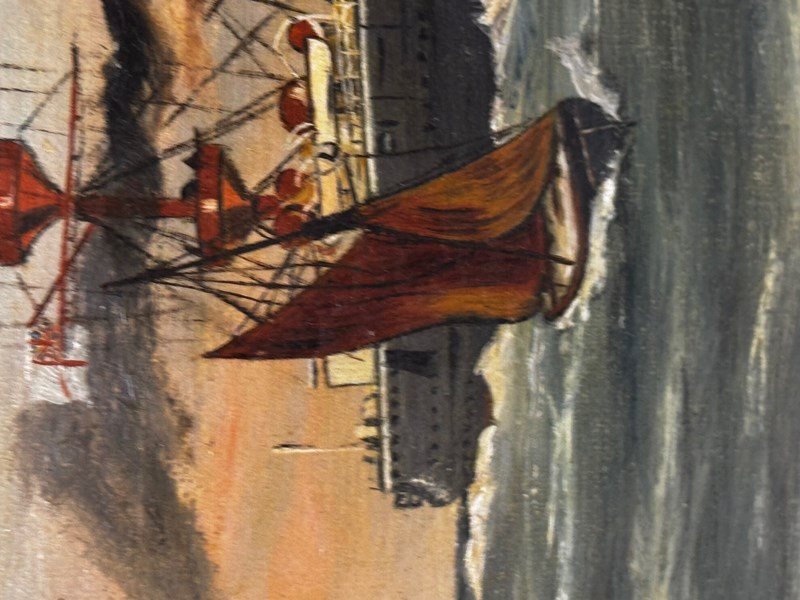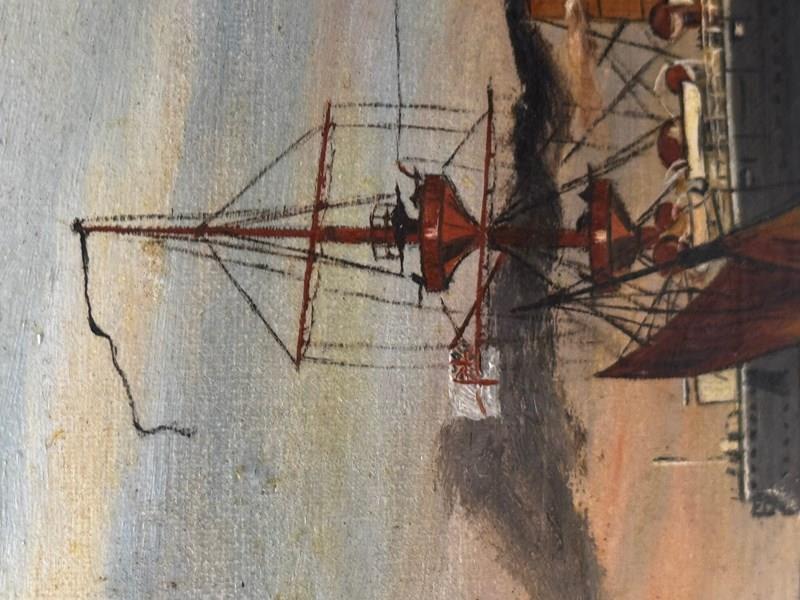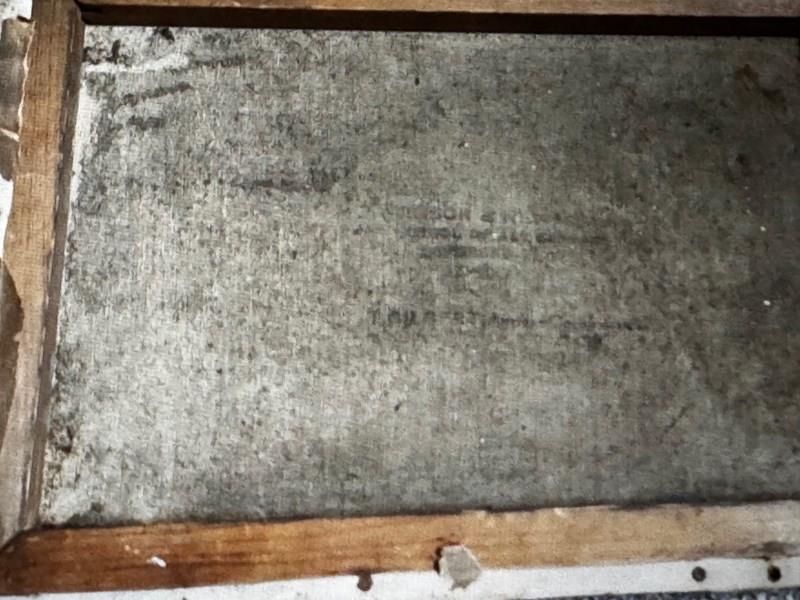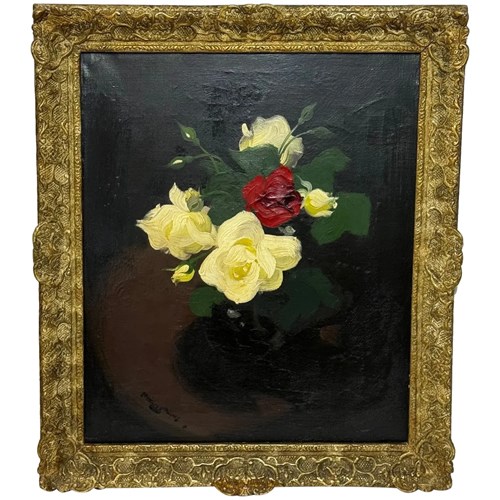Oil Painting HMS Powerful Royal Navy Cruiser Ship Follower Charles Dixon
Stock No
CACL464
2023
- £4,500.00
- €5,250 Euro
- $5,972 US Dollar
Questions about this item?
Like this item?
Item Description
English Historical Marine Oil Painting HMS Powerful Royal Navy Cruiser Ship Follower Of Charles Dixon.
Impress your clients & guests, make a great art statement with this historic maritime steamer ship masterpiece to display on your office wall space or home interior.
Title “HMS Powerful Royal Navy Protected Steamer Cruiser Ship” Follower of Charles Dixon.
Subject marine seascape view of the known historical British Royal Navy Warship cruiser HMS Powerful The ship is steaming along in side profile heading right, on relatively choppy high seas, some sailor crew figures can be seen out on deck, two large look out masts with rigging & 4 notable funnels which are pumping out black smoke. Past the bridge is a large turret main gun on the bow. Further back are white longboats. The Union Jack ensign flag flying above at the stern. Above mixed blue and overcast grey sky. Sailing along the ship is a much smaller fishing boat.
Circa early 20th century 1900's.
Follower in the style of Charles Dixon.
Signed by the English artist R Warr.
Set in a decorative recent gilt frame which enhances this work even further, with a front protective AR70 glass cover.
Oil on canvas.
Hanging thread on the back ready for immediate wall display.
Origin from the United Kingdom.
A rather nice proportion-sized frame being 47 cm wide and 36.5 cm high.
HMS Powerful was the lead ship of her class of two protected cruisers built for the Royal Navy (RN) in the 1890s. The builder was Vickers Limited, Barrow-in Furness, laid down on 10 March 1894 and launched on 24th July 1895. Commissioned on 8th June 1897, she was later renamed in 1919 as Impregnable. She was initially assigned to the China Station and then provided landing parties which fought in the Siege of Ladysmith of 1899–1900 during the Second Boer War. After a lengthy refit, the ship was placed in reserve until 1905 when Powerful became the flagship of the Australia Station. Upon her return home in 1912, she was again reduced to reserve for a brief time before she was reclassified as a training ship. The ship remained in this role until 1929 when she was sold for scrap.
The Powerful-class cruiser was designed to counter the Russian armoured cruiser Rurik which had been designed as a long-range commerce raider. This required long range and high speed to catch the Russian ship. The ships displaced 14,200 long tons (14,400 t) at normal load. They had an overall lengthof 538 feet (164.0 m), a beam of 71 feet (21.6 m) and a draught of 27 feet (8.2 m). The ships were powered by a pair of four-cylinder triple-expansion steam engines, each driving one propeller shaft, using steam provided by 48 Belleville boilers. The engines were designed to produce a total of 25,000 indicated horsepower (19,000 kW) at forced draught and gave a maximum speed of 22 knots (41 km/h; 25 mph). Powerful reached a maximum speed of 21.8 knots (40.4 km/h; 25.1 mph) from 25,886 ihp (19,303 kW) during her sea trials. She carried enough coal to give her a range of 7,000 nautical miles(13,000 km; 8,100 mi) at 14 knots (26 km/h; 16 mph) and her complement consisted of 894 officers and ratings.
The main armament of the Powerful-class cruisers consisted of two 9.2-inch (234 mm) Mk VIII guns in single gun turrets, one each fore and aft of the superstructure.[1] Her secondary armament of a dozen 6-inch (152 mm) Mk I or II guns was arranged in casemates amidships. The end casemates were the first two-storey (guns on the main and upper decks) casemates in the RN. For defence against torpedo boats, sixteen 12-pounder 3-inch (76 mm) 12-cwt guns and a dozen 3-pounder (47 mm (1.9 in)) Hotchkiss guns were fitted. Two additional 12-pounder 8-cwt guns could be dismounted for service ashore. The ships also mounted four submerged 18-inch (450 mm) torpedo tubes, a pair on each broadside. With the exception of the barbettes, which used mild steel, all of the protective plating of the cruisers was Harvey armour. The curved protective deck ranged in thickness from 2.5–4 inches (64–102 mm) and the conning tower was protected by 12 inches (305 mm). The armour of the gun turrets, their barbettes and the casemates was 6 inches thick. The casemates had 2-inch (51 mm) backs.
Brief biography of Charles Edward Dixon (8 December 1872 – 12 September 1934) was a British maritime painter of the late nineteenth and early twentieth centuries, whose work was highly successful and regularly exhibited at the Royal Academy. Several of his paintings are held by the National Maritime Museum and he was a regular contributing artist to magazines and periodicals. He lived at Itchenor in Sussex and died in 1934. His works have fetched at auction houses up to $82,385 US dollars.
Provenance from a private marine collection & in collection of Cheshire Antiques Consultant LTD
Offered in fine used condition.
Painting surface is in good overall order condition, having foxing staining and craquelure in areas, also some minor paint touch-ups towards the edges. The frame is in excellent order with some imperfections commensurate with being handmade.
International buyers worldwide shipping is available.
Dimensions in centimetres of the frame
High (36.5 cm)
Wide (47 cm)
Depth (3 cm)
Item Info
Seller Location
Covent Garden, London
Item Dimensions
H: 36.5cm W: 47cm D: 3cm
Period
1900's
Item Location
United Kingdom
Seller Location
Covent Garden, London
Item Location
United Kingdom
Seller Contact No
+44 (0)7494 763382
More from CHESHIRE ANTIQUES CONSULTANT LTD
